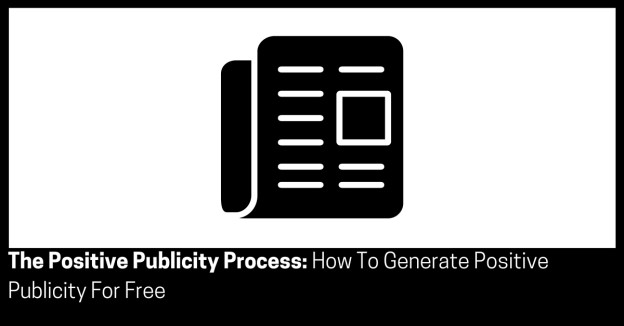Approximate read time: 9 minutes
There are only two ways to generate positive publicity:
- Do interesting things; and
- Pitch interesting things.
And to do them you need to the following elements:
- STEP 1: Determine Your Objectives;
- STEP 2: Select Distribution Channels;
- STEP 3: Gather Publicity Stories;
- STEP 4: Pitch A Story;
- STEP 5: Get Published;
- STEP 6: Acknowledge Publication; and
- STEP 7: Evaluate Your Publicity.
Let’s begin with…

1) Determine Your Objectives
Publicity is pretty simple…
The first step is about defining your objectives.
Positive publicity is useful for quite a few things.
And I have listed some of the main objectives of publicity:
- It increases brand awareness;
- It inserts your story into published media;
- It leverages 3rd party credibility and influence associated with media to objectively position you;
- It legitimises your activity via printing on the public record;
- It influences your Google search engine result page rankings (SERPs) via published backlinks;
- It increases marketing reach and traffic for most kinds of stakeholders; and
- It gains attention for your message.
And publicity does all of this for free.
You can’t get better than that!
But, before we go on, you need to know who your target audience is for your publicity activity and how you will measure your publicity activity.
You don’t need my help for the former, but the latter is based on those 7 objectives.
At this stage, it’s also important to make you aware of some of the economics of publicity.
Of course, the exact details of how to do this are beyond the scope of this guide, but media, like most businesses is driven by revenue.
It sounds obvious.
Broadly revenue comes from two sources:
- Consumers;
- Advertisers; or
- A combination of both.
Hence describing this as a continuum.
The revenue source determines the type of content the outlet will publish.
Let me repeat:
The revenue source determines the type of content the outlet will publish.
Practically, this could be based on:
- The length and nature of content; or
- The modality, such as audio, video or text.
Of course, the exact details of how to do this are beyond the scope of this guide, but this should give you a quick idea.
This leads us to selection distribution channels.

2) Select Distribution Channels
Step 2 is about selecting relevant and related distribution channels that match with the audience you want to target for your publicity message.
Selection of publicity distribution channels is determined by the objectives you identified in Step 1, naturally.
This means researching keywords on Google and identifying target outlets, then ranking those outlets on the following criteria:
- Their Alexa.com rank – Alexa provides insights into popularity of websites on the web;
- Their beat – which is niche area over coverage; and
- Their region – if that is applicable to isolating your message to a particular geography.
There are many others, which are beyond the scope of this guide, but these are useful to help prioritise your list in order of who you will pitch for the maximum amount of free positive publicity.
These prioritisation factors include similar stories published in the past or if you have a relationship with that outlet.

3) Gather Publicity Stories
This step is about gathering what you do that is newsworthy and interesting.
Then you match those things with publicity opportunities – based off their relevance and relatedness to the outlets audience.
I separate opportunities to pull and push opportunities.
Pull opportunities are more ad hoc and they include:
- Call outs – call out websites are websites that match outlets who have content they want to publish with sources or experts who have experience in that same content. You reply to call out requests explaining how you can help;
- Twitter can be used similarly. Outlets or individual publishers of target outlets on Twitter sometimes do callouts for sources or experts who have experience in that same content they are about to publish; and
- News jacking – is a bit of push and pull opportunities. It plays on words – hi jacking a news trend. What news trends are happening currently or in your industry that you can attach your message to; one of the big ones right now for almost anyone who exchanges money to take advantage of is Bitcoin.
You should be following all relevant outlets you identified, be monitoring and replying to callouts.
You must also monitor media trends for relevant keywords for your brand, audience and message for news jacking ideas.
Pull opportunities help you start a relationship with outlets, which leads us to push opportunities.
Push opportunities are more proactive and they include:
- Evergreen Content – this is the type of content that are always interesting and exciting. Examples include things with a human element, Newness and Controversy. And these could translate into things like, giving big data, a stunt or new contracts won; and
- Expanded Content – each of these could be standalone for a single outlet such as an exclusive, however expanding your content enables you to give it to multiple outlets. This could be in the form of extra sources, photos or angles.
Brainstorm publicity ideas based on evergreen content and general publicity guidelines, including a hook, headline, angle, importance and significance.
A crucial part of this is thinking about how you will expand that content to follow up with multiple outlets.
It’s best to float these publicity ideas with an unbiased network of publicity minded people to crowdsource feedback.
This is because what you think is newsworthy, may not be objectively newsworthy.
It’s an easy mistake to make.
People always loose objectively when they are seeking publicity for something they are emotionally involved in.
No one likes to hear their baby is ugly!
Don’t be mistaken.
Most miss the next step: completing a risk assessment.
When looking at what content you may have, it’s worth considering risk potential risks with your messages.
Remember this is about POSITIVE publicity.
And for higher risk stories, you need to mitigate its risk.
Do a risk assessment with a risk matrix.
Once you have identified the risks then work out how you will mitigate them.
And then work out how you will respond if a crisis happens regardless of rumour or truth.
As such, it’s smart to schedule a crisis plan once a year.
If in the rare instance you have a crisis, it’s worth knowing how to manage reputations with things like DMCA takedown notices and Google’s removal policy.
Of course, there are more, not covered in this guide, but these mentioned are the “80/20.”
Next up, we move on to…

4) Pitch A Story
This step is all about pitching your story to outlets.
This starts with making initial contact and introducing yourself.
Then building some goodwill with that outlet.
An effective way to do this is by giving an outlet content that is not directly related to you or your brand.
In other words, not self-promoting – this could be about others in your industry.
So, then once you have a story, you briefly re-pitch the outlet.
This time, your message will be well received!
What follows is a decision tree of sorts.
Here are the possibilities…
If an outlet is not interested in what you are pitching, follow them up with expanded content from Step 3.
Don’t rush – don’t ask them to publish.
If the outlet is interested, move on to writing a press release or doing an interview directly on the phone, depending on what they need.
Most people start their publicity campaign with a press release and it gets completely ignored, because there is no relationship with that outlet, nor has the outlet shown interest in what you are pitching.
Sending blind press releases has become so common place that it comes across as spam.
Spam is not good, okay?
Your press release needs the correct format, structure and elements which are, of course, beyond the scope of this guide.
Prepare the spokesperson (this may be you) with a copy of the press release, talking points, any additional elements pitched as expanded content.

5) Get Published
Step 5 is not an actual step.
Cheeky!
If you have done everything correctly until now, you have a very highly likelihood of being published or have already been published.
There is no action step here except patting yourself on the back for doing interesting things and being recognised for that via publication.
So, what is next?

6) Acknowledging Publication
Acknowledging publication is next…
This step is about acknowledging publication for so that you can continue to pitch that outlet well into the future.
This includes the following:
- Building readership leverage by sending new prospects or via your network to the publication for further readership;
- Gaining further readership through press release distribution services (most people do this before anything else in hopes outlets will pick it up. BIG MISTAKE);
- Saying “thank you” to the outlet for publishing the story and telling them you have also shared it; and
- Determining if you should send paid traffic to the article.
Got it?
Good!
This sequence has some particular nuance to it and to get the most out of it requires being astute to the subtleties, which I don’t have time to spell out here.
Onward…

7) Evaluate Your Publicity
Step 7, the final step, is about evaluating your effort:
- Establishing Google Alerts for keywords related to the campaign to see who else has publicized based on your initial pitches;
- Watching hashtags for publication and spread;
- Measuring publication against your objectives in Step 1 to determine if the publicity campaign was valuable for your brand (this may include the number of outlets which published and the approximate dollar amount of equivalent advertisement rate for those media mentions, amongst other things which are beyond the scope of this guide);
- Collecting a summary of all the publicity activity for your records; and
- Monitoring the articles comments session for any required response.

Take Action
You made it…
You now have a solid plan for generating positive publicity.
That’s the full Positive Publicity Process and will be more than enough for you to get started on your own.
You can get the printed illustrated Process Map of this and 20 others for free, here
And if you’re serious about marketing and selling more, the logical next step is to contact me to help you do it yourself, have me do it with you, or have it all done for you.
This maybe the momentum you need to get great marketing and sales results.
Now let’s learn about The Social Media Marketing Process.
Or do you simply want more like this?
Join below to be notified immediately about new content and more. No annoying daily emails and no spam – just good content when it’s posted.

